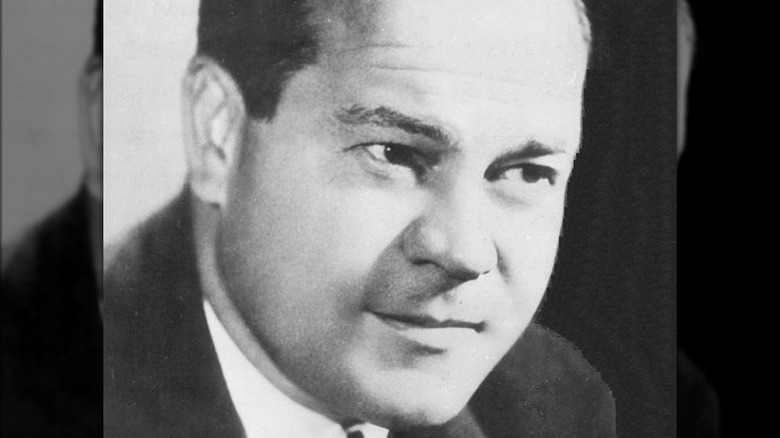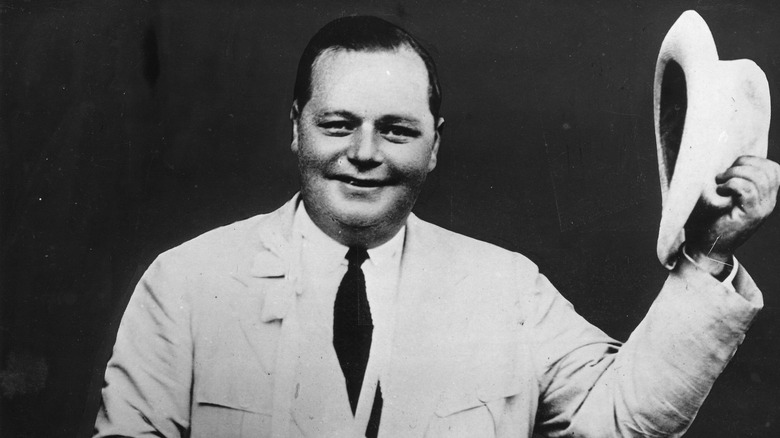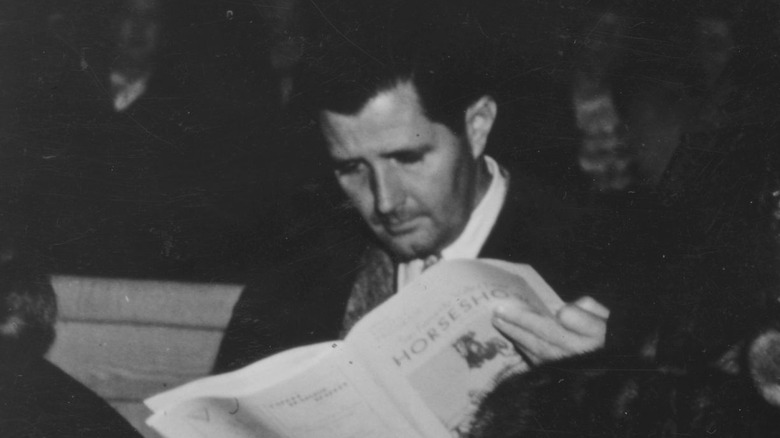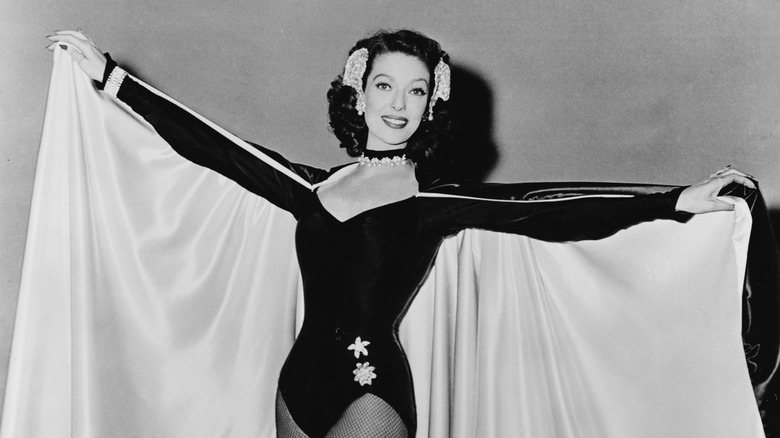How Eddie Mannix Became The Fixer Of Old Hollywood
One of the most intriguing characters in Old Hollywood wasn't a performer. In fact, he was better off operating in the shadows, picking up the pieces of a star's problems and protecting the studio's image from scandal and harm. Eddie Mannix was a fixer, although his official titles were the general manager and comptroller for MGM studios. Together with the studio's head of public relations, Howard Strickling, Mannix had a hand in covering up Hollywood scandals that had the potential to sink entire careers.
Mannix protected stars like Clark Gable, but also shielded off-screen staff from allegations of criminal misconduct (via Buzzfeed News). Mannix was intensely loyal to MGM Studios, and that would seem to be his reason for going to such extreme lengths to protect its image. In fact, according to Slate, he kept a sign on his desk that read, ""THE ONLY STAR AT MGM IS LEO THE LION!" a reference to the studio's famous roaring lion mascot.
Early Hollywood scandals led to the need for fixers
Frankly, there's no real need for a fixer if everyone on the studio's books just keeps their noses clean, but everyone is human and things happen. Even early in its existence, the film industry could bring in piles of cash, and much like today, some films could almost assure a studio of a hefty profit just by having a big-name star attached. One of the earliest examples of this was Roscoe "Fatty" Arbuckle. According to Smithsonian Magazine, in 1918 Arbuckle signed a massive three-year contract worth $3 million with Paramount Pictures and produced 18 silent films. In 1921, he re-upped with Paramount — once again signing a deal with the studio, a deal that was worth millions — and went to celebrate the deal with his friends over Labor Day at a hotel in San Francisco.
The celebration wound up ruining Arbuckle's career. He was charged with manslaughter in relation to the death of Virginia Rappe, a 25-year-old actress. While Arbuckle was eventually acquitted of the charges, the ordeal completely tanked his career and ultimately changed the film industry. The studios hired Will Hays to serve as a censor soon after Arbuckle's trial, and the new industry censor handed down a ban on the former silent film star that outlawed him from appearing on screen. While the ban was eventually lifted, one of Paramount's biggest cash cows was relegated to off-screen work, and that was only after he started working under the pseudonym William Goodrich.
Eddie Mannix joins forces with Howard Strickling
In the years that followed the Arbuckle scandal, studios wanted to protect their stars and their investments in them. Joseph Schenk was an agent who represented big names like Buster Keaton and Marilyn Monroe over his career, but also represented Fatty Arbuckle. Schenk would've seen the damage the scandal caused to both his client and Paramount firsthand (via Film Reference). Meanwhile, his brother, Nicholas, was one of the higher-ups at Metro-Goldwyn-Meyer — or MGM studios. According to Atlas Obscura, the Schenks discovered Eddie Mannix while the latter was doing construction on the brother's New Jersey amusement park. Mannix was a tough guy and known to have connections in the criminal underworld, but he was nonetheless brought into the MGM fold.
By the 1930s, Mannix was general manager of MGM Studios and he was eventually partnered with Howard Strickling, the studio's head of public relations. Before joining MGM, Strickling was a journalist, and his knowledge of the press, coupled with Mannix's machoism and underworld connections, made them a formidable — if not slightly unusual — duo, the fierce defenders of the studio's image (via Slate).
The Mannix/Strickling fixing strategy
According to Slate, the Stickland-Mannix partnership worked as follows: If a Hollywood star or starlet found themselves in a bit of trouble they called either Strickling or Mannix and the two went to work. Strickling used his journalistic knowledge to perform some sleight of hand with any member of the Fourth Estate who sniffed too close to the scandal that he and Mannix were trying to hide. If need be, Stickland would give journalists another story — one deemed acceptable in its effect on the studio's image — in exchange for their willingness to look the other way.
Meanwhile, as Strickling handled keeping the scandals out of the headlines, Mannix was responsible for dealing with the actual problems and pickles in which the studio's finest found themselves. According to Vanity Fair, Mannix wasn't just helping actors out of bum parking tickets or jaywalking citations; at times, he was doing whatever he could to cover serious crimes. Some have alleged that Mannix was responsible for covering up a rape charge levied at an MGM salesman. There are even persistent rumors that Mannix may have had something to do with the death of George Reeves, best known for playing Superman on television, although the actor's 1959 death was officially ruled a suicide (via Wired). According to Smithsonian, Mannix may have once covered for actor Clark Gable — something that happened on more than one occasion — when the star wound up in a car crash that led to the death of a pedestrian.
Mannix and Strickling ran stars' personal lives
The general public's fascination with celebrities' personal lives was very much a thing during Mannix and Strickling's day, and that kept them busy. The pair were known to keep close tabs on studio stars and went to great lengths to tuck away aspects of an actor's personal lives that could harm their careers or the studio's reputation. Mannix and Strickling were known to facilitate sham marriages in hopes of keeping closeted gay actors' sexuality under wraps, and if an unwed starlet found herself pregnant, they'd see it to it that she received an abortion.
One of the most famous examples of their extreme methods involved actress Loretta Young. According to Atlas Obscura, Young — who was 23 years old at the time — became pregnant. The father was her co-star and frequent Mannix focus, Clark Gable. Gable was married at the time, and years later, Young's daughter revealed that the sexual encounter between her mother and Gable may not have been consensual (via Buzzfeed News). In situations like this, Mannix and Strickling would typically advise the actress to get an abortion, but Young was a devout Catholic and refused. Mannix and Strckling had an idea to get Young and MGM Studios through this situation, but it was highly unorthodox.
Loretta Young adopted her own biological child
This was 1935, and the idea of an unwed woman becoming pregnant was considered scandalous. So, Mannix and Strickling concocted a two-year plan that involved sending Young away, telling the media first that she was on vacation, but later, when her absence persisted, that she had fallen ill. Strickling eventually had an extremely pregnant sit down — or, rather, lay down — for an interview with a journalist that was also a good friend of his, per Atlas Obscura. Young laid in bed for the interview, and Strickling meticulously arranged pillows to hide her pregnant stomach. This was Hollywood after all, so there was some showiness to the whole affair. To hammer home the idea of Young being sick, a nurse was brought in to swap out fake I.V. bags.
Young eventually gave birth to a healthy baby girl, who was then kept at a house in Venice Beach, California, before she was placed in an orphanage. Young announced her intentions to adopt two orphans, but eventually one of the adoptions (the one of the non-existent second child) fell through. She officially adopted the girl — her own biological daughter — and the possible scandal was behind both Young and MGM. Young revealed the truth to her daughter in 1966, but Mannix and Strickling's secret ruse was so under wraps that the public wasn't made aware of until 2000, when Young discussed it in her posthumous memoir, according to Buzzfeed News.
Eddie Mannix's legacy
Eddie Mannix is a vestige of a seedy era in the history of Hollywood, but that doesn't mean he failed to leave his mark. According to Vice, a fictionalized version of Mannix, played by Josh Brolin, is the main character in the Coen Brothers' 2016 film "Hail, Caesar!" While Mannix's exploits have become the stuff of Hollywood lore, he had another, maybe unexpected, contribution that has been immensely helpful to film scholars.
According to Den of Geek, Mannix died in 1963, but during his lifetime he was a meticulous bookkeeper. In line with his official roles within MGM Studios, Mannix kept a ledger that was filled with all kinds of financial information related to the studio and its films. This included information on the cost to make just about every MGM film between 1924 and 1962. The Mannix Ledger is part of a collection kept by the Academy of Motion Picture Arts and Sciences known as the Howard Strickling Papers.






